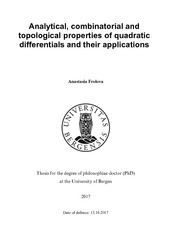Analytical, combinatorial and topological properties of quadratic differentials and their applications
Doctoral thesis

Åpne
Permanent lenke
https://hdl.handle.net/1956/17411Utgivelsesdato
2017-12-13Metadata
Vis full innførselSamlinger
Sammendrag
Quadratic differentials first appeared in 1930s in works of Teichmuller in connection with moduli problem for Riemann surfaces. Later it was revealed that quadratic differ- entials and their trajectories give solutions to extremal problems for moduli of families of curves and extremal partition of Riemann surfaces. Over the last decades there has been discovered a connection between quadratic differentials and extremal problems of different nature related to minimal surfaces, potential theory, approximation theory, mathematical physics. In this work, we study quadratic differentials, discover new properties of certain types of quadratic differentials and explore the connection of quadratic differentials with other disciplines, such as discrete mathematics, topology and even applied math- ematics. We apply the theory of quadratic differentials to solve problems of complex analysis and study analytical problems that are connected with quadratic differentials. The dissertation is organized as follows. Chapter 1 contains an introduction to the notions and facts that are necessary for understanding the main results of this work. Section 1.1 gives a short introduction to quadratic differentials and their trajectory structure. It also recalls the definition of reduced moduli of digons. Section 1.2 de- scribes the tools from discrete mathematics and topology that are used in this work. Chapter 2 gives a summary of the research papers that constitute the main scientific contributions of the thesis. Both Chapter 1 and Chapter 2 are followed by lists of refer- ences. The following papers are included in Chapter 3. Paper A: A. Frolova, M. Levenshtein, D. Shoikhet, and A. Vasil’ev, Boundary distortion estimates for holomorphic maps, InComplex Analysis and Operator Theory, 8 (2013), no. 5, 1129–1149. Paper B: A. Frolova, A. Vasil’ev, Combinatorial description of jumps in spectral networks, accepted to Proceedings AMS. Paper C: A. Frolova, D. Khavinson, and A. Vasil’ev, Polynomial lemniscates and their fingerprints: from geometry to topology, Submitted to New Trends in Complex and Harmonic Analysis. Paper D: A. Frolova, M. Solberg, and A. Vasil’ev, Pure braids and homotopy classes of closed loops, paper in preparation. In Paper A we apply extremal partitions and moduli of digons to obtain a boundary distortion estimate for a conformal self-mapping of the unit disk with two fixed points on the boundary. Paper B studies combinatorial structure of the family of quadratic differentials with a finite simple pole that possess a short trajectory. In Paper C we discover some properties of fingerprints of polynomial lemniscates and construct a non-unitary operad that realizes a process of approximation of two dimensional shapes by polynomial lemniscates. In Paper D we define an action of a braid group on homotopy classes of closed curves on a punctured sphere, which is related to a problem of constructing an operad on quadratic differentials with several double poles.
Består av
Paper A: A. Frolova, M. Levenshtein, D. Shoikhet, and A. Vasil’ev, Boundary dis- tortion estimates for holomorphic maps, In Complex Analysis and Operator Theory, 8 (2013), no. 5, 1129–1149. Full-text not available. The published version is available at: https://doi.org/10.1007/s11785-013-0345-zPaper B: A. Frolova, A. Vasil’ev, Combinatorial description of jumps in spectral networks, accepted to Proceedings AMS. http://hdl.handle.net/1956/17412
Paper C: A. Frolova, D. Khavinson, and A. Vasil’ev, Polynomial lemniscates and their fingerprints: from geometry to topology, Submitted to New Trends in Complex and Harmonic Analysis. Full-text not available.
Paper D: A. Frolova, M. Solberg, and A. Vasil’ev, Pure braids and homotopy classes of closed loops, paper in preparation. Full-text not available.